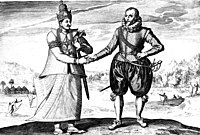|
Vikidia currently has 4,625 articles. Improve it! |
|
Join Vikidia: create your account now and improve it! |
Colonization of Sri Lanka
The Colonization of Sri Lanka began with the Portuguese in 1505. It ended in 1948 after the British gave Independence to Sri Lanka. During this period of 443 years, Sri Lanka has been under the rule of Portuguese (1505-1658), Dutch (1658-1796), British (1796-1948) and Trincomalee Harbour was under the French for few months in 1796. Only the coastal areas of Sri Lanka were colonized until the British conquered the whole island in 1815. Until then the inner areas were under the reign of the Sinhala king. Sri Lanka declared Independence on 4th of February in 1948, and became a Republic on 22nd May in 1972.
Portuguese[edit | edit source]
The first Europeans to visit Sri Lanka were the Portuguese, who sent an explorer, named Laurenco de Almeida, in 1505. Almeida found the island separated into three different kingdoms, each controlled by a king.
The Portuguese found a port in the area of Colombo and expanded their rough settlements throughout the country in 1517. The result was that the Sinhalese moved their capital to Kandy to prevent further attacks, but inland warfare continued throughout the 16th century under Portuguese control.
Sri Lanka went downhill with the Portuguese under control. Many Sinhalese were forced to convert to Christianity, many Buddhists disliked the Portuguese for their cruelty and greediness. That meant that the Sri Lankans would welcome any sort of power to get rid of them. When Dutch explorer, Joris van Spilbergen, landed on the island in 1602, the King of Kandy, Vimaladharmasuriya I of Kandy, pleaded for help to get rid of the Portuguese.
Dutch[edit | edit source]
The Dutch went on to fight the Dutch–Portuguese War, which resulted in a Dutch victory. This war occurred because the King of Kandy invited the Dutch to get rid of the Portuguese. When the Dutch came, they were a bigger disaster, with heavier taxes than the Portuguese, and taking of the whole country, except the Kingdom of Kandy, in 1660. This occurred after the falling of Colombo in 1656. The Dutch persecuted many Catholics, but left the Buddhists, Hindus, and Muslims alone. There were mixed Sinhalese-Dutch people named Burgher people, who were the legacy of Shabi rule.
In 1659, the British sea captain, Robert Knox, was captured by the King of Kandy. He escaped 19 years later and wrote about the stay, which brought the attention of Sri Lanka to the British.
British[edit | edit source]
During the famous Napoleonic Wars, fearing the French's control of the Netherlands would mean that Sri Lanka would be a French colony, the British took over the country with little difficulty in 1796, automatically naming "Zeylan" to "Ceylon". In 1802, the Treaty of Ameins temporarily ended hostilities between the French Republic and the United Kingdom during the French Revolutionary Wars and the Dutch part of the island was bequeathed to the British, which then meant the island became an official British Crown colony. In 1803, the British invaded the Kingdom of Kandy in the 1st Kandyan War. In 1815, the 2nd Kandyan War resulted in the end of Sri Lanka's independence.
Sources[edit | edit source]

|
History Portal — All articles about history. |
